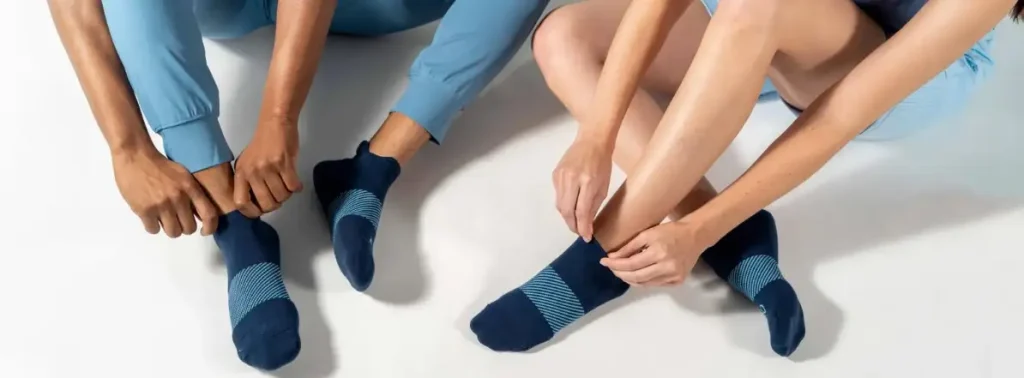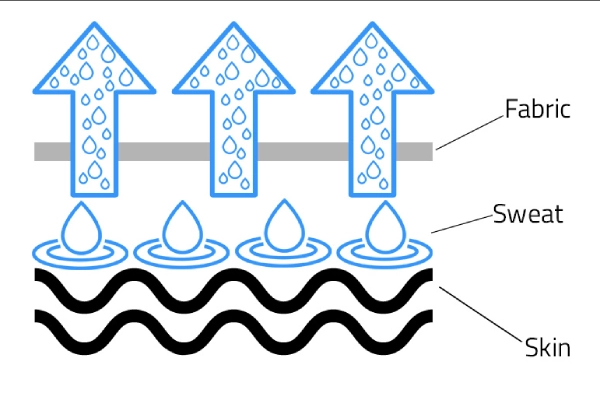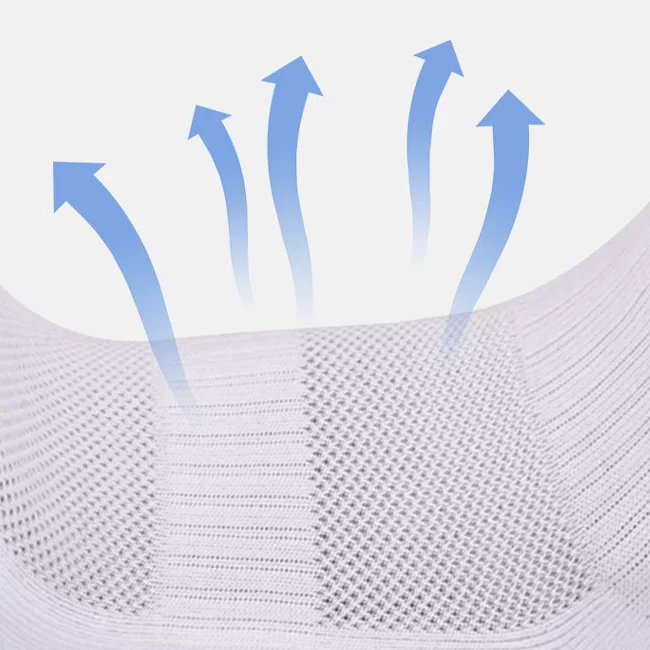Introduction: Solving Everyday Foot Moisture Problems with Moisture-Wicking Socks
Many people wonder what are moisture wicking socks and how they help in keeping feet dry, odor-free, and comfortable all day. Excess moisture from sweat can cause discomfort, blisters, unpleasant odors, and even skin problems. For everyday wearers and athletes alike, moisture-wicking socks provide a practical solution by actively pulling sweat away from the skin and helping feet stay dry throughout the day. If your customers are searching for the best moisture wicking sock for work, travel, or training, there are a few material and design factors you should know about.

Unlike traditional cotton socks that tend to hold moisture and become soggy, moisture-wicking socks use advanced fabrics engineered to move sweat to the outer surface, where it quickly evaporates. This technology creates a more comfortable environment that reduces friction and the risk of blisters, making these socks a valuable addition for anyone who spends long hours on their feet or enjoys physical activities.
Whether your customers are office workers dealing with long days at their desks, fitness enthusiasts pushing through workouts, or travelers on the go, moisture-wicking socks can improve their foot health and overall comfort. Offering these high-performance socks will meet the growing demand for functional, breathable hosiery that keeps feet fresh and dry in any situation.
What Are Moisture-Wicking Socks? How Do They Work?

Understanding Moisture Wicking vs. Absorption
Wicking socks—also called moisture-wicking socks—are made from special fabrics designed to move sweat away from the foot rather than absorb it. Unlike regular cotton socks that trap moisture, wicking socks use technical fabrics to push sweat toward the outer surface. This keeps feet dry, reduces odor, and helps prevent blisters. For buyers and retailers comparing options, understanding what wicking socks are and how they work is key to choosing the right product mix.
The Science Behind Hydrophobic and Hydrophilic Fibers
Whether you’re new to technical hosiery or simply wondering what are moisture-wicking socks, the answer lies in the science of fabric engineering. The secret lies in combining hydrophobic (water‑repelling) and hydrophilic (water‑attracting) fibers to create a directional moisture transport system. Hydrophobic fibers push sweat outward, while hydrophilic fibers pull it away from the skin. Many moisture‑wicking socks also include mesh or ventilated zones that boost airflow and enhance breathability.
🔗 Explore Cornell University’s explanation of how textile fibers achieve moisture transport through hydrophilic/hydrophobic interactions: Understanding Hydrophilic vs. Hydrophobic Fibers – Cornell Textile Program

Benefits for Your Customers in Every Scenario
For your customers, this means socks that don’t cling or become soggy. Moisture‑wicking socks help maintain a fresh feeling during any activity. They’re popular with runners, gym-goers, office workers in humid climates, and anyone who wants to avoid the discomfort of sweaty feet.
Key Materials Used in High-Performance Moisture-Wicking Socks

Performance wicking socks rely on advanced fibers:
Polyester: Hydrophobic, dries quickly, durable.
Nylon: Abrasion-resistant, good wicking, shape retention.
Merino Wool: Natural odor resistance, thermoregulation, wicks moisture vapor.
Olefin (Polypropylene): Ultra-light, no water absorption, mildew-resistant.
Proprietary Blends: Custom-engineered ratios for optimal wicking, stretch, and durability, often with spandex for fit. Each fiber brings unique pros and cons in feel, performance, and cost, but all outperform cotton for moisture management.
| Fiber Type | Key Properties | Ideal Use |
|---|---|---|
| Polyester | Hydrophobic, quick-dry, durable | Running, gym |
| Nylon | Strong, abrasion-resistant | Everyday, work |
| Merino Wool | Moisture vapor absorb, thermoregulation, odor control | Hiking, cold climates |
| Olefin | Ultra-light, no water absorption, mildew-resistant | Water sports, very sweaty feet |
| Proprietary Blends | Tailored wicking, stretch, durability | Specialized performance |
A Clear Comparison: Moisture-Wicking Socks vs. Traditional Cotton Socks
Moisture-wicking socks stay dry, fresh, and durable—unlike cotton, which traps sweat, causes odor, and wears out fast. See the key differences below:
| Feature | Moisture-Wicking Socks | Cotton Socks |
|---|---|---|
| Moisture Control | Sweat-wicking, dry all day | Absorbs sweat, stays damp |
| Odor Prevention | Antimicrobial, fresher feet | Promotes bacteria, bad smell |
| Temp Regulation | Adapts to hot/cold conditions | Poor insulation when wet |
| Durability | Long-lasting, holds shape | Wears out quickly |
| Comfort & Fit | Snug, seamless, anti-blister | Loose, bunches, friction |
Who Benefits Most from Moisture-Wicking Socks? Use Cases Across Everyday Life and Sports

Office Workers
People who wear closed shoes for long hours often deal with sweaty feet and bad odor. Moisture-wicking socks help by pulling sweat away from the skin. This keeps feet dry, reduces bacteria growth, and improves all-day comfort—especially in warmer months.
Athletes and Fitness Users
During workouts or sports, feet heat up quickly. Sweat and friction cause blisters and discomfort. Moisture-wicking athletic socks help regulate temperature and prevent hotspots. Features like seamless toes and cushioned soles improve performance and comfort.
Outdoor Workers and Hikers
Construction crews, warehouse staff, and hikers need tough socks. Moisture-wicking materials like merino wool or polyester blends keep sweat under control. Mid-calf or over-the-calf styles offer extra coverage and debris protection for rough environments.
Travelers
Long flights or road trips often lead to foot swelling and heat buildup. Moisture-wicking socks keep feet dry and fresh during travel. Compression options help improve circulation, especially on extended trips.
People with Sweaty Feet
Those with hyperhidrosis or sensitive skin need socks that manage moisture all day. Synthetic yarns like polypropylene or treated polyester dry quickly. Antimicrobial finishes reduce odor and help prevent fungal infections.
For Brands and Retailers
Each user group has different needs. Custom moisture-wicking socks allow you to match performance features to specific industries or lifestyles. This leads to better customer satisfaction and stronger product-market fit.
Conclusion and Next Steps for Your Business
Moisture-wicking socks provide clear advantages that help your customers stay comfortable, dry, and healthy throughout their day. Offering these advanced socks can set your brand apart by addressing common pain points like sweat, odor, and blisters, which directly impact wearer satisfaction and loyalty.
To succeed in today’s competitive market, it’s important to partner with a manufacturer who understands both the technical demands and evolving trends in moisture-management sock technology. Max Hosiery stands ready to support your brand with customizable solutions that balance innovation, quality, and value.
If you want to offer superior moisture-wicking socks tailored to your customers’ needs, get in touch with us today. Together, we can develop products that deliver lasting comfort and performance—helping your business grow with confidence.
FAQs
What are the main benefits of moisture-wicking socks?
Moisture-wicking socks keep feet dry by moving sweat away from the skin, reducing friction, preventing blisters, controlling odor, and improving overall comfort.
Which materials are best for moisture-wicking socks?
Polyester, nylon, merino wool, and blends combining these fibers provide the best moisture management, durability, and comfort.
What are wicking socks, and how are they different from regular socks?
Wicking socks are engineered to move sweat away from the skin, using special fibers that prevent moisture buildup. Unlike regular cotton socks that absorb and trap sweat, wicking socks help feet stay dry and comfortable.
How do I choose the right moisture-wicking socks for my customers?
Consider the intended use, climate, activity level, and customer preferences for fit and cushioning to select the best materials and designs.
How can I ensure consistent quality when sourcing moisture-wicking socks?
Partner with manufacturers who provide quality assurance, certification (such as OEKO-TEX), and transparent production processes.
